Weiss put forward a second hypothesis, namely domain hypothesis. He postulated that the atomic dipole of an atom strongly interacts to the neighbouring atom by a quantum mechanical interaction called exchange interaction. He explain why a sample of ferromagnetic material has spontaneous magnetisation.
Explanation
- The entire ferromagnetic volume splits into a large number of small regions called Domains. These domains are spontaneously magnetised.
- The size of a domain varies from 10−6 m to the entire size of the crystal.
- A domain acts as a single magnetic dipole. Within the domains, all the spin magnetic moments are oriented in one specific direction.
- The domains are all magnetised in different directions as illustrated in Fig (a).
- Within each domain, the magnetic moments (spin) are oriented parallel to the another and energy of each domain is characterised by a definite value and direction of the magnetic field.
- In the absence of an external magnetic field, even though the magnetic moment vectors of the separate domains are oriented in all probable directions the net magnetic moment exist within the material. All the domains are separated from the other domains by the Domain wall (or) Block wall.
- Such a piece of ferromagnetic material is said to be unmagnetised.
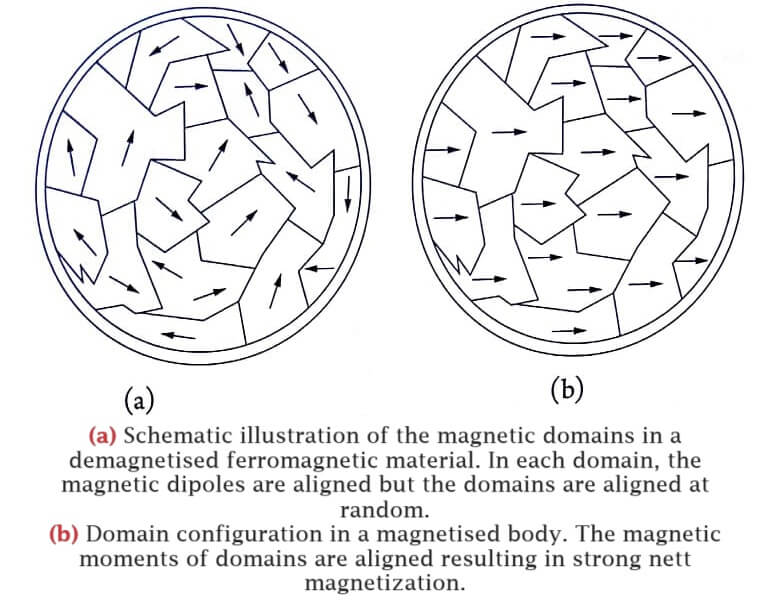
- When the material is subjected to an external magnetic field, the domain rotate and attempt to align their magnetic moments with the field direction instead of the individual atomic dipoles attempting to line up parallel to the field. Fig (a & b).
- Though in each domain spontaneous magnetisation is due to parallel alignment of all magnetic dipoles, the direction of spontaneous magnetization varies from domain to domain. But resultant magnetization exist within the material.
When an external magnetic field is applied, there are two possible ways of alignment of a random domain.
By the movement of domain walls
Movement of domain walls take place in weak magnetic field. When a small magnetic field is applied, the domains with magnetization direction becomes parallel or nearly parallel to the field, grow at the expense of others as shown in Fig (b).
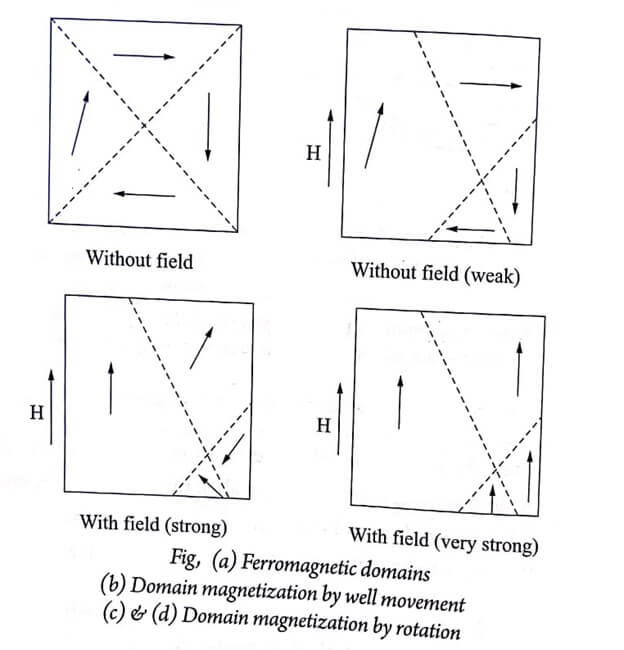
By rotation of domains
Rotation of domain walls occurs during strong magnetic field. As the magnetic field is increased to a larger value (near saturation), further domain growth becomes impossible. Therefore, most favourably oriented and fully grown domains tend to rotate so as to be in complete alignment with the field direction (Fig (c & d)).
Domain Energies and Explanation for Origin of Domains
The total internal energy of the domain structure in a ferromagnetic material is made up from the following contributions.
- Exchange energy (or) Magnetic field energy.
- Crystalline energy (or) Anisotropy energy.
- Domain wall energy (or) Bloch wall energy.
- Magnetostrictive energy.
(i) Exchange energy (or) Magnetic field energy
“The interaction energy which makes the adjacent dipoles align themselves” is the called exchange energy (or) magnetic field energy.
It arises from interaction of electron spins. It depends upon the interatomic distance. This exchange energy also called magnetic field energy. It is the energy required in assembling the atomic magnets into a single domain and this work done is stored as potential energy. The size of the domains for a particular domain structure may be obtained from the principle of minimum energy. The volume of the domain may very between say, 10−2 to 10-6 cm3.
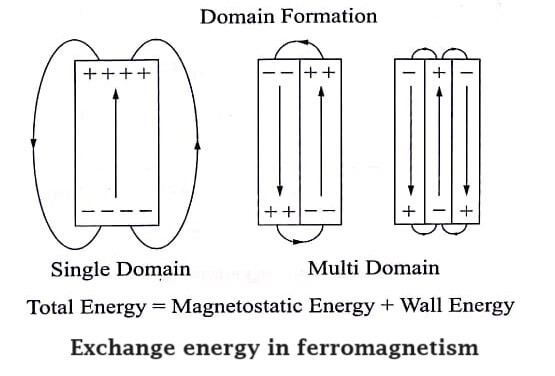
(ii)Anisotropy energy
The excess energy required to magnetize a specimen in particular direction over that required to magnetize it along the easy direction is called the crystalline anisotropy energy.
In ferromagnetic materials there are two types of directions of magnetization namely, (i) easy direction and (ii) hard direction.
In easy direction of magnetization, weak field can be applied and in hard direction of magnetisation, strong field should be applied.
Crystalline anisotropy energy is energy of magnetization which is the function of crystal orientation. In Fig magnetization curves for iron with the applied field along different crystallographic directions have been drawn.
For example, in BCC iron the easy direction is [`100], the medium direction is [110], and the hard direction is [111]. The energy difference between hard and easy direction to magnetise the material is about 1.4×104 Jm−3. This energy is very important in determining the characteristic domain boundaries.
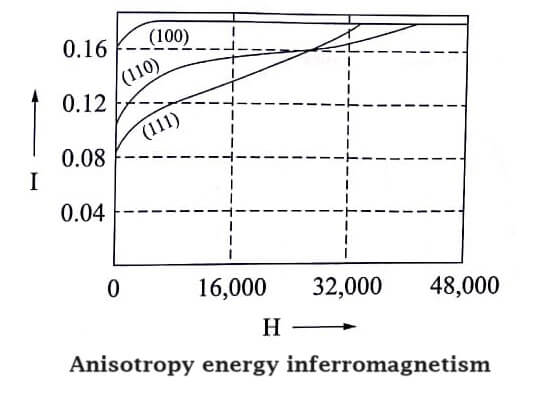
(iii) Domain wall energy or Bloch wall energy
A thin boundary or region separates adjacent domains magnetized in different directions is called domain wall or bloch wall.
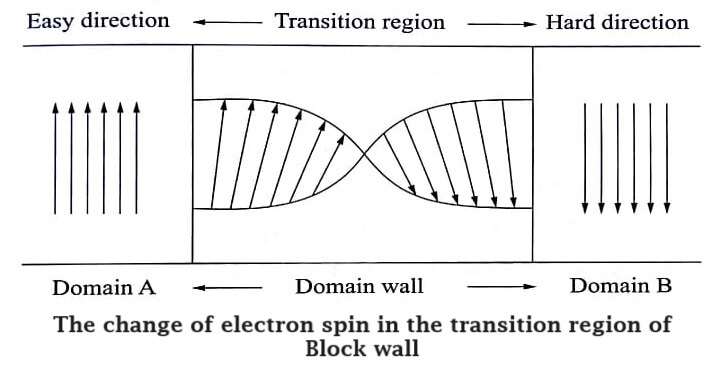
The size of the bloch walls are about 200 to 300 lattice constant thickness. In going from one domain to another domain, the electron spin changes gradually as shown in fig.
The energy of domain walls is due to both exchange energy and anisotropic energy.
Based on the spin alignments, two types of bloch wall may arise, namely
Thick wall : When the spins at the boundary are misaligned and if the direction of the spin changes gradually as shown fig. It leads to a thick bloch wall. Here, the misalignment of spins are associated with exchange energy.
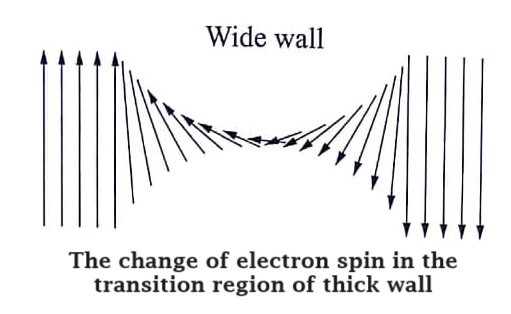
Thin wall : When the spins at the boundaries changes abruptly, then the anisotropic energy becomes very less. Since the anisotropic energy is directly proportional to the thickness of the wall, this leads to a thin Bloch wall.
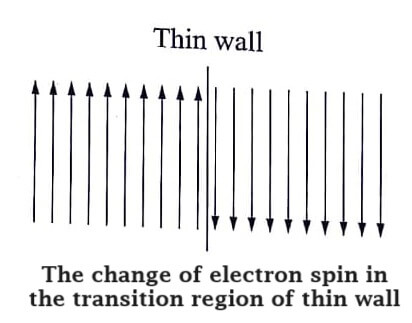
(iv) Magnetostrictive energy
When a material is magnetized, it is found that it suffers a change in dimensions. This phenomenon is known as Magnetostrictive.
This deformation is different along different crystal directions. So if the domains are magnetized in different directions, they will either expand or shrink. This means that work must be done against the elastic restoring forces. The workdone by the magnetic field against these elastic restoring forces is called the magneto-elastic energy or magnetostrictive energy.
| Read More Topics |
| Definition and properties for ferromagnetism |
| Definition and properties for paramagnetism |
| Definition and properties for diamagnetism |





